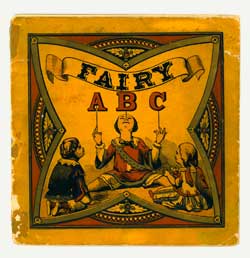The Exhibit
Nothing compares with the expression on the face of someone long past childhood seeing a book remembered fondly from their first fifteen years of life. It is amazing how many of us can recite the entirely of a favorite book that we loved [and our parents hated] that we read or had read to us thousands of times. And we, for our part, might admit sheepishly that after reading it out loud four times every night for three years, we hate GOODNIGHT MOON.
Books for children make a huge and lasting impact on us and on society. On exhibit here are books from a range of places and times—many topics are covered but 20 some are focused on. Here we learn both our letters and numbers as well as our morality, sense of discovery and common history. We are exposed to both geometry and the elephant. We see what a watchmaker does or learn that if you cut school in the 19th century you would probably be eaten by lions as a punishment. We are shown crudely colored woodcuts and detailed hand painted intaglio illustrations. These books were intended to educate—sometimes to entertain and enchant as well. We hope you are entertained, enchanted and educated by this exhibition.
Why Collect Historical Children's Books?
Why would an academic library such as that at the University of Washington want to collect historical children's books? We give you just a few reasons why. Children's books can be used for the intense study of many topics, genres and disciplines: the history of printing and book illustration, particularly in the development of the use of color; for the study of the gradual changes in familiar tales to reflect changes in societal acceptance and sensibilities [how do the stories of Cinderella or Red Riding Hood or The Gingerbread Boy change over time?]; the study of social and ethnic history [Epaminondas and Little Black Sambo]; the role of women [when in children's books do women become pilots rather than cabin attendants?]; changing views of “basic” education skills [penmanship, manners, grammar, elocution], changing styles of authority [when does an alphabet based on the Bible become unacceptable for public school use?]; and the study of educational pedagogy itself. Special Collections are grateful to the many donors who have contributed anything from the grandmother who saved a single, tattered, much loved volume to those who trust us with the treasures of a lifetime of collecting. Through children's books we can trace who we are, who we have been and who we hope to become.



